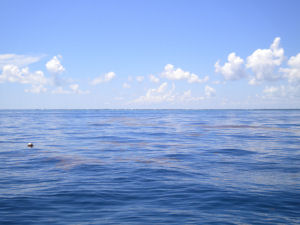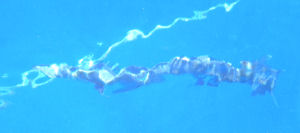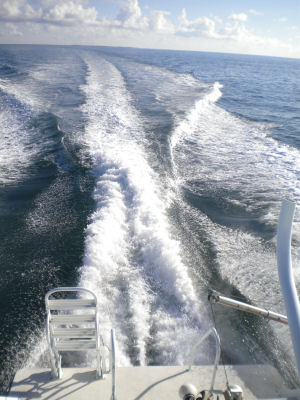A magical day
It's time for the PI to put fingers to keyboard and finally blog in. Today was one of those magical days at sea when nature puts on a show, the unexpected surprises, and everything works. After making sure Fetch1 hadn't pulled a fast one and woken up without permission, we set sail for Conch Reef on the R/V George Bond at 0830. The seas were calm with gently, easy to fall asleep to swell, which hypnotized one unnamed graduate student on the way out. When we tied up at the habitat mooring, we realized the water was very clear and we were parked right over the habitat. Soon Sarina and Noelle were in the water

snorkeling, oohing and ahhing at the big schools of fishes, including dozens of toothy barracuda that hang out at the Life Support Buoy (LSB). Sargassum rafts drifted by with a host of expertly camouflaged fishes of various species. The water also had millions of tiny colonies of Trichodesmium (sea sawdust), a cyanobacterium that can use nitrogen from the atmosphere directly. The colonies look like little grains of wheat or sawdust as they drift by in the surface layer. (First described by Captain Cook, Trichodesmium is found around the world in nitrogen poor waters, and helps feed microscopic organisms.)
 We started running Fetch in straight lines directly over the
habitat. Each run lasted 3 min and covered about 300 m. We soon had our first
surprise. Each time Fetch swam by the LSB, 10-20 barracuda would rapidly
mobilize and follow the robot!
We started running Fetch in straight lines directly over the
habitat. Each run lasted 3 min and covered about 300 m. We soon had our first
surprise. Each time Fetch swam by the LSB, 10-20 barracuda would rapidly
mobilize and follow the robot!
The first few dives were only 12 feet (4 m) deep, so we were able to watch our Macy's Parade as it passed by our boat. According to the snorkelers, the view was pretty cool as the fish chased the robot. We wanted to see with these runs whether Fetch could thread the needle amongst the spiderweb of lines underwater that run between surface buoys, the habitat, and the LSB, as it collected side scan sonar and video data. We changed depths and headings and had success on all of our 3 dozen or so dives, except for 2. The first event was Fetch catching a mooring line and pulling out a cable that transmits GPS data from Fetch's dorsal fin to the flight computer (an ancient Apple PowerPC). The second was when Fetch got snagged again, and then extracted itself (a special behavior programmed into the AUV does this), but surfaced directly under the LSB. This latter event occurred just as the batteries were getting low anyway, so we called it a day for AUV ops, and Noelle, Chris, and Sarina braved the barracuda fan club to swim out to the robot and recover it.
We also have a pH probe mounted on the vehicle. Ocean acidification is a huge concern for marine scientists and we have started gathering data on Conch Reef's pH. As the planet warms because of more carbon dioxide (CO2) in the atmosphere, a lot of this gas is dissolving in sea and making the oceans more acidic. This concerns marine scientists as many organisms have skeletal structures made out of calcium carbonate, including the skeletons of corals. A more acidic ocean will make it harder for these organisms to build skeletons, including some very important single-celled plant plankton. Our pH probe on Fetch allows us to see how variable the acidity is on the scale of the reef. But Fetch has a limitation. It can't get super close to the bottom, because then it might hit a coral head. (We usually don't let it get closer than 9 feet (3 m) to the bottom.
So the end of our day at sea saw Noelle and myself diving down to measure pH ourselves, using a handheld instrument, with Fetch's pH probe plugged in. Today's experiment was to see whether pH of the seawater right next to the corals is different from water nearby. We dove near Aquarius and found several coral heads to make our measurements. Noelle recorded data on an underwater writing pad, a piece of plastic called a "slate" that you write on with a lead pencil. While the measurements where being taken I couldn't help but take peeks at the readings on the instrument's digital display. It appeared we had measurable changes in the water around corals, probably a result of the photosynthesis taking place in the tissue of the coral. Corals have symbiotic algae living inside them, and these algae help feed the coral by making carbohydrate for them.
The ride back took us through cerulean shallows, where patches of seagrasses flashed by, flying fish skimmed and skittered from our high speed approach, and sea turtles bobbed. I'll remember this day on the water for a long time.

